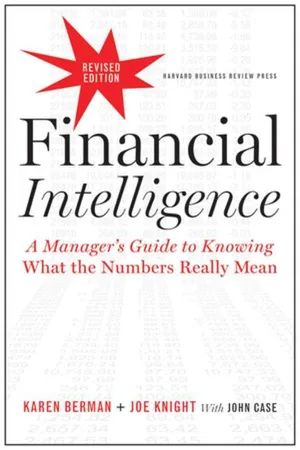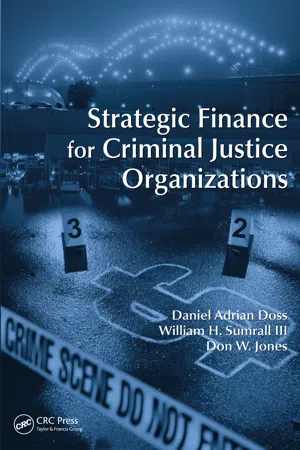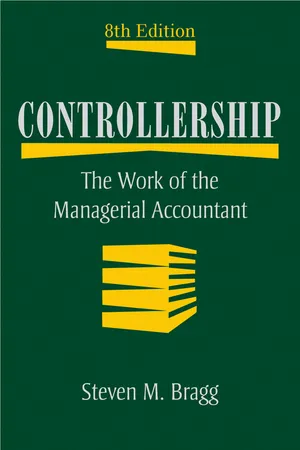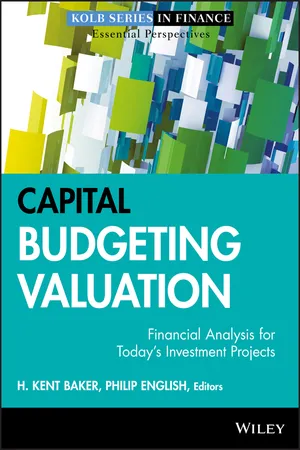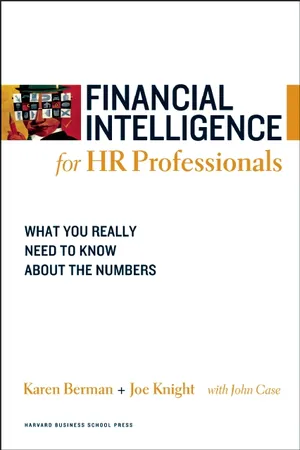Business
Internal Rate of Return
The Internal Rate of Return (IRR) is a metric used to evaluate the profitability of an investment. It represents the discount rate at which the net present value of the investment becomes zero. In essence, it is the rate of return at which the present value of the investment's costs equals the present value of its benefits.
Written by Perlego with AI-assistance
Related key terms
10 Key excerpts on "Internal Rate of Return"
- eBook - ePub
Making the Compelling Business Case
Decision-Making Techniques for Successful Business Growth
- W. Messner(Author)
- 2013(Publication Date)
- Palgrave Macmillan(Publisher)
So, when is a ROI calculation useful? One can really only use the ROI method in business cases to compare the ROI of investment projects to other previous (successful) investments or with an industry average. But this is not only difficult, because as we all know from the stock market, the success rate of past investments is not a good indicator for future performance and should therefore not influence today’s decisions. And what is even more important is, as the ROI calculation formula is not uniformly defined, the business case team could run the danger of comparing apples with pears.2.5 Internal Rate of Return (IRR)
The Internal Rate of Return (IRR) is a handy measure which is frequently used in finance departments. However, as the examples in this chapter will show, it can also be a very misleading metric. IRR is defined as the rate of return that makes the NPV zero. In order to find the IRR for a proposed investment, the following equation needs to be solved: There is no ambiguity in calculating the IRR for an investment that only generates one single cash flow after one period. In fact, the calculation is pretty simple:The expression for longer investment periods is much more difficult, if not impossible, to solve arithmetically and usually requires a trial-and-error linear interpolation approach, for which a spreadsheet such as the one in Figure 2.6 comes very handy.Let us revert to the previous real estate example and modify it a little: After an initial investment of $470,000 into real estate, the investor now expects a rental income of $30,000 p.a. There is a plan to sell the real estate in the fifth year for $500,000. A trial-and-error interpolation, as shown in Figure 2.9 using the NPV formula results in an IRR ≈ 6.38%, which is the rate of discount at which the investment’s NPV becomes zero (NPV - eBook - ePub
Financial Intelligence, Revised Edition
A Manager's Guide to Knowing What the Numbers Really Mean
- Karen Berman, Joe Knight, John Case(Authors)
- 2013(Publication Date)
- Harvard Business Review Press(Publisher)
Another potential drawback—the art of finance, again—is simply that NPV calculations are based on so many estimates and assumptions. The cash flow projections can only be estimated. The initial cost of a project may be hard to pin down. And different discount rates, of course, can give you radically different NPV results. Still, the more you understand about the method, the more you can question somebody else’s assumptions—and the easier it will be to prepare your own proposals, using assumptions that you can defend. Your financial intelligence also will be clear to others—your boss, your CEO, whoever—when you present and explain NPV in a meeting to discuss a capital expenditure. Your understanding of the analysis will allow you to explain with confidence why the investment should be made, or why it should not.Internal Rate of Return MethodCalculating Internal Rate of Return is similar to calculating net present value, but the variable is different. Rather than assuming a particular discount rate and then inspecting the present value of the investment, IRR calculates the actual return provided by the projected cash flows. That rate of return can then be compared with the company’s hurdle rate to see if the investment passes the test.In our example, the company is proposing to invest $3,000, and it will receive $1,300 in cash flow at the end of each of the following three years. You can’t just use the gross total cash flow of $3,900 to figure the rate of return, because the return is spread out over three years. So we need to do some calculations.First, here’s another way of looking at IRR: it’s the hurdle rate that makes net present value equal to zero. Remember, we said that as discount rates increase, NPV decreases? If you did NPV calculations using a higher and higher interest rate, you’d find NPV getting smaller and smaller until it finally turned negative, meaning the project no longer passed the hurdle rate. In the preceding example, if you tried 10 percent as the hurdle rate, you’d get an NPV of about $212. If you tried 20 percent, your NPV would be negative, at –$218. So the inflection point, where NPV equals zero, is somewhere between 10 percent and 20 percent. In theory, you could keep narrowing in until you found it. In practice, you can just use a financial calculator or a Web tool, and you will find that the point where NPV equals zero is 14.36 percent. That is the investment’s Internal Rate of Return.IRR is an easy method to explain and present, because it allows for a quick comparison of the project’s return to the hurdle rate. On the downside, it does not quantify the project’s contribution to the overall value of the company, as NPV does. It also does not quantify the effects of an important variable, namely how long the company expects to enjoy the given rate of return. When competing projects have different durations, using IRR exclusively can lead you to favor a quick-payback project with a high-percentage return when you should be investing in longer-payback projects with lower-percentage returns. IRR also does not address the issue of scale - Daniel Adrian Doss, William H. Sumrall III, Don W. Jones(Authors)
- 2017(Publication Date)
- Routledge(Publisher)
In Missoula, Montana, the consideration of a 20% to 25% rate of return was considered regarding public capital initiatives. Only projects that demonstrated a potential rate of return of at least 20% were categorized as acceptable. This rate of return would only be applicable to initiatives that demonstrated “very little risk and uncertainty,” and contracting firms would also “seek a return closer to 40 percent for projects with moderate risk.” † From the perspective of law enforcement use, the IRR is a tool through which potential capital investments may be examined. Such capital investments often are associated with the planning, structuring, and implementation of retirement systems. The use of the IRR may be applied to considerations of retirement systems and retirement planning among agencies and personnel. During 2009, the Fort Lauderdale Police and Fire Pension Board considered the use of such returns within the context of retirement projections among city personnel. ‡ Similarly, the cities of Richmond Heights, Missouri, § and Lakeland, Florida, ¶ also considered the rate of return as a method through which its retirement valuations occurred. These examples show the potency of the IRR method as a tool through which capital budgeting decisions may be embellished. The use of the IRR method provides a tool through which an additional examination of capital initiatives may occur through considerations of whether potential capital initiatives are worthwhile investment pursuits through time. Regardless, the IRR is a tool through which organizational leaders may examine a rate with respect to the characteristics of the considered problem domain. 7.3 Internal Rate of Return (IRR) Method The IRR is a capital budgeting tool that is used primarily to determine the potential profitability of capital investments through time. The period of time may be either strategic or tactical. Regardless, the basic concepts of the IRR are applicable within both situations- eBook - ePub
Finance
Capital Markets, Financial Management, and Investment Management
- Frank J. Fabozzi, Pamela Peterson Drake(Authors)
- 2009(Publication Date)
- Wiley(Publisher)
The index value is greater than one, which means that the investment produces more in terms of benefits than costs. An advantage of using the profitability index is that it translates the dollar amount of NPV into an indexed value, providing a measure of the benefit per dollar investment. This is helpful in ranking projects in cases in which the capital budget is limited.The decision rule for the profitability index depends on the PI relative to 1.0, which meansInternal Rate of Return
Suppose an investment opportunity requires an initial investment of $1 million and has expected cash inflows of $0.6 million after one year and another $0.6 million after two years. This opportunity is shown in Figure 14.3 using a time line.The return on this investment (denoted by Internal Rate of Return or IRR, in the next equation) is the discount rate that causes the present values of the $0.6 million cash inflows to equal the present value of the $1 million cash outflow, calculated asAnother way to look at this is to consider the investment’s cash flows discounted at the IRR of 10%. The NPV of this project if the discount rate is 13.0662% (the IRR in this example), is zero:An investment’s Internal Rate of Return is the discount rate that makes the present value of all expected future cash flows equal to zero. We can represent the IRR as the rate that solves Going back to Project X, the IRR for this project is the discount rate that solves Using a calculator or a computer, we get the answer of 10.172% per year.FIGURE 14.3Timeline of Investment OpportunityLooking back at the investment profiles of Projects X and Y, each profile crosses the horizontal axis (where NPV = 0) at the discount rate that corresponds to the investment’s IRR. This is no coincidence: by definition, the IRR is the discount rate that causes the project’s NPV to equal zero.The IRR is a yield—what is earned, on average, per year. How do you use it to decide which investment, if any, to choose? Let’s revisit Projects X and Y and the IRRs we just calculated for each. If, for similar risk investments, owners earn 10% per year, then both Projects X and Y are attractive. They both yield more than the rate owners require for the level of risk of these two investments: - eBook - ePub
Controllership
The Work of the Managerial Accountant
- Steven M. Bragg(Author)
- 2009(Publication Date)
- Wiley(Publisher)
Accordingly, the discounted cash flow principle has been adopted as a far superior tool in ranking and judging the profitability of the investments. The principle may be applied in two forms:- The investors’ method, also known as the Internal Rate of Return (IRR)
- The net present value (NPV)
The first one actually involves the determination of what rate of return is estimated. The second method applies a predetermined rate, or hurdle, to the estimated stream of cash to ascertain the present value of the proposed investment.Investors’ Method: Internal Rate of Return
Technically, the rate of return on any project is that rate at which the sum of the stream of after-tax (cash) earnings, discounted yearly according to present worth, equals the cost of the project. Stating it another way, the rate of return is the maximum constant rate of return that a project could earn throughout the life of the outstanding investment and just break even.The method may be simply described by an example. Assume that an investment of $1,000 may be made and, over a five-year period, cash flow of $250 may be secured. What is the rate of return? By a cut-and-dry method, and the use of present value tables, we arrive at 8 percent. The application of the 8 percent factor to the cash flow results in a present value of approximately $1,000 is:
The proof of the computation is the determination of an 8 percent annual charge with the balance applicable to principal, just as bankers calculate rates of return.Year 8% Annual Cash Flow (a) Discount Factor (b) Present Value (a) × (b) 1 $ 250 .926 $ 232 2 250 .857 214 3 250 .794 198 4 250 .735 184 5 250 .681 170 Total present value $ 998 Year Cash Flow (A) Return at 8% of Investment Outstanding at Beginning of Year (B) Balance Applicable to Investment (C) = 5 (A − B) Outstanding Investment at Year-End (D) 0 $ — $ — $ — $1,000 1 250 80 170 830 2 250 66 184 646 3 250 52 198 448 4 250 36 214 234 5 250 19 231 3∗ ∗ Due to rounding. By trial and error, application of the proper discount factor can be explored until the proper one is found. Using a 10 percent discount factor and a 40 percent discount factor, the $1,000,000 assumed investment, discussed in connection with other evaluation methods, to be recouped over 10 years, results in a 36 percent rate of return, as shown in Exhibit 27.4 - eBook - ePub
- E.J. Mishan, Euston Quah(Authors)
- 2020(Publication Date)
- Routledge(Publisher)
outlay of 121 at the end of the second year – thus an investment stream equal to −100, 220, −121 – a discount rate equal to 10 per cent, reduces the present value of that stream to zero. The IRR is, therefore, equal to 10 per cent.Inasmuch, then, as in conforming to the formula, both outlays and benefits are to be discounted to the present at the IRR, it will sometimes be neater to obviate mention of the initial outlay K and any subsequent outlays, treating them instead as negative net benefits in the year they occur. The formula then becomesin which B t can be positive, negative or zero∑t = 0n= 0 ,B t1 + λtIt will be convenient, henceforth to continue using negative B s for any subsequent outlays. Nonetheless, it should be understood that, although there can also be negative net benefits in future years that are in fact not cash outlays, being instead possible losses arising from environmental damage or compensatory payment, it makes no difference in the calculation of the IRR – or, for that matter, of the DPV, given the discount rate.13 The sense in which the Internal Rate of Return, so defined, is an average over time is conveyed by the example of a man investing, say, 100 for five years. If the Internal Rate of Return of some given investment stream were 25 per cent per annum, the man would have in mind an equivalent , though simpler, investment in which his 100 in the present grows by 25 per cent each year. He sees his 100 in the present becoming 125 by the end of the first year,156.25by the end of the second year, and so on, to reach 100(1 + 0.25)5 by the end of the fifth year. More generally, if the investment stream in question were −100, B 1 , B 2 , B 3 , B 4 , B 5 , where the B s are any pattern of benefits, and the Internal Rate of Return were known to be 25 per cent, then an equivalent investment stream would be −100,0,0,0,0, 100[(1 + 0.25)5 ], for this given investment stream, when discounted to its present value at 25 per cent, is, by assumption, equal to zero, and so also is the equivalent stream. Consequently, if a man is told that the internal rate of an investment stream over n years is equal to λ, he is justified in thinking of the investment as equivalent to one in which his initial outlay is compounded forward at the rate of λ per annum for n - eBook - ePub
Capital Budgeting Valuation
Financial Analysis for Today's Investment Projects
- H. Kent Baker, Philip English(Authors)
- 2011(Publication Date)
- Wiley(Publisher)
Whether companies actually follow or maintain such a policy is questionable. Further, using a single rate for all cash flows no matter when the cash flows occur in the future is an issue within an NPV analysis as discussed in Chapter 4. Leaving such issues aside, a similar claim of the firm maintaining a constant reinvestment rate cannot be made with an IRR analysis. Future projects having the same IRR as current projects is an unlikely scenario. Such a scenario cannot be the by-product of company policy to maintain a particular debt and equity mix yielding a stable NPV discount rate. A particular debt and equity mix could maintain a specific weighted average cost of capital (WACC), which analysts could use as the RADR within an NPV analysis.As stated earlier, IRR is the discount rate that sets NPV to zero, but it cannot be precisely interpreted as the actual return generated by the project. To illustrate the issue, use one of the projects from the previous section: initial cost of $10,000 followed by four annual cash inflows of $3,500 beginning next year. The project's IRR is 14.963 percent, but assuming the firm can reinvest intermediate cash flows at 10 percent annually, what is the actual return on the project? The four cash inflows at the end of the project are worth $16,243.50 (=$3,500.00((1.10)4 − 1)/0.10), making the annual return on the project 12.894 percent (=(($16,243.50/$10,000.00)0.25 − 1). Notice that the project's actual return is lower than the IRR. If the reinvestment rate were 14.963 percent (i.e., equal to the IRR) instead of 10 percent, the actual return would be equal to the IRR.Assuming the above discussion convinces a decision maker to consider reinvestment rates (Solomon, 1956; Renshaw, 1957; Teichroew, Robichek, and Montalbano, 1965a, 1965b; Dudley, 1972; Dorfman, 1981), Marglin (1963) offers the following question: What reinvestment rate should be used? Solomon suggests an opportunity cost expressed as a rate for the reinvestment rate and concludes that the reinvestment rate should be the firm's cost of capital. The only cost to be considered is the initial cost and all the following cash flows accrue interest at the cost of capital until the project ends. The terminal value of all the cash flows with interest is then compared to the initial cost to find a holding period return that is compared to a hurdle rate. This process is exactly what is performed previously, assuming that 10 percent is the cost of capital (reinvestment rate) to find the project return of 12.894 percent and is a variant of what Lin (1976) calls the modified Internal Rate of Return (MIRR). - eBook - ePub
Financial Intelligence for Entrepreneurs
What You Really Need to Know About the Numbers
- Karen Berman, Joe Knight(Authors)
- 2008(Publication Date)
- Harvard Business Review Press(Publisher)
In our example, you are proposing to invest $3,000, and your business will receive $1,300 in cash flow at the end of each of the following three years. You can’t just use the gross total cash flow of $3,900 to figure the rate of return because the return is spread out over three years. So we need to do some calculations.First, here’s another way of looking at IRR: it’s the hurdle rate that makes net present value equal to zero. Remember, we said that as discount rates increase, NPV decreases. If you did NPV calculations using a higher and higher interest rate, you’d find NPV getting smaller and smaller until it finally turned negative, meaning the project no longer passed the hurdle rate. In the preceding example, if you tried 10 percent as the hurdle rate, you’d get an NPV of about $233. If you tried 20 percent, your NPV would be negative, at – $262. So the inflection point, where NPV equals zero, is somewhere between 10 percent and 20 percent. In theory, you could keep narrowing in until you found it. In practice, you can just use a financial calculator or a Web tool, and you will find that the point where NPV equals zero is 14.36 percent. That is the investment’s Internal Rate of Return.IRR is an easy method to explain and present because it allows for a quick comparison of the project’s return to the hurdle rate. On the downside, it does not quantify the project’s contribution to the overall value of the company, as NPV does. It also does not quantify the effects of an important variable, namely how long the company expects to enjoy the given rate of return. When competing projects have different durations, using IRR exclusively can lead you to favor a quick-payback project with a highpercentage return when you should be investing in longer-payback projects with lower-percentage returns. IRR also does not address the issue of scale. - eBook - ePub
- Wai-Sum Chan, Yiu-Kuen Tse;;;(Authors)
- 2017(Publication Date)
- WSPC(Publisher)
For simplicity, we assume the cash flows occur at regular intervals, say, annually. The project lasts for n years and the future cash flows are denoted by C 1,···, C n. We adopt the convention that cash inflows to the project (investments) are positive and cash outflows from the project (withdrawals) are negative. We define the Internal Rate of Return (IRR) (also called the yield rate) as the rate of interest such that the sum of the present values of the cash flows is equated to zero. Denoting the Internal Rate of Return by y, we have where j is the time at which the cash flow C j occurs. This equation can also be written as The right-hand side of the above equation is the present value of future outflows (withdrawals) minus the present value of future inflows (investments). Thus, the net present value of all future withdrawals (injections are negative withdrawals) evaluated at the IRR is equal to the initial investment C 0. Example 4.1: A project requires an initial cash outlay of $2,000 and is expected to generate $800 at the end of year 1 and $1,600 at the end of year 2, at which time the project will terminate. Calculate the IRR of the project. Solution: If we denote we have, from (4.2) or Dropping the negative answer from the quadratic equation, we have Thus, Note that v < 0 implies y < − 1, i.e., the loss is larger than 100%, which will be precluded from consideration. ■ Equation (4.1) is formally the same as the equation of value (1.36), with the focus being on the solution of y given the cash flows C j, j = 0,···, n. Indeed, Example 4.1 is similar to Example 1.23, with the problem viewed as one on investment rather than loan. In many practical situations, the cash flows can be calculated or estimated, and the IRR provides a measure of the attractiveness of the project. There is generally no analytic solution for y in (4.1) when n > 2, and numerical methods have to be used. The Excel function IRR enables us to compute the answer easily - eBook - ePub
Financial Intelligence for HR Professionals
What You Really Need to Know About the Numbers
- Karen Berman, Joe Knight(Authors)
- 2008(Publication Date)
- Harvard Business Review Press(Publisher)
Another potential drawback—the art of finance, again—is simply that NPV calculations are based on so many estimates and assumptions. The cash flow projections can only be estimated. The initial cost of a project may be hard to pin down. And different discount rates, of course, can give you radically different NPV results. Still, the more you understand about the method, the more you can question somebody else’s assumptions—and the easier it will be to prepare your own proposals, using assumptions that you can defend. Your financial intelligence also will be clear to others—your boss, your CEO, whomever—when you present and explain NPV in a meeting to discuss a capital expenditure. Your understanding of the analysis will allow you to confidently explain why, or why not, the investment should be made.Internal Rate of Return Method
Calculating Internal Rate of Return is similar to calculating net present value, but the variable is different. Rather than assuming a particular discount rate and then inspecting the present value of the investment, IRR calculates the actual return provided by the projected cash flows. That rate of return can then be compared with the company’s hurdle rate to see whether the investment passes the test.In our example, the company is proposing to invest $3,000, and it will receive $1,300 in cash flow at the end of each of the following three years. You can’t just use the gross total cash flow of $3,900 to figure the rate of return because the return is spread out over three years, so we need to do some calculations.First, here’s another way of looking at IRR: it’s the hurdle rate that makes net present value equal to zero. Remember, we said that as discount rates increase, NPV decreases. If you did NPV calculations using a higher and higher interest rate, you’d find NPV getting smaller and smaller until it finally turned negative, meaning the project no longer passed the hurdle rate. In the preceding example, if you tried 10 percent as the hurdle rate, you’d get an NPV of about $233. If you tried 20 percent, your NPV would be negative, at – $262. So the inflection point, where NPV equals zero, is somewhere between 10 percent and 20 percent. In theory, you could keep narrowing in until you found it. In practice, you can just use a financial calculator or a Web tool, and you will find that the point where NPV equals zero is 14.36 percent. That is the investment’s Internal Rate of Return.
Index pages curate the most relevant extracts from our library of academic textbooks. They’ve been created using an in-house natural language model (NLM), each adding context and meaning to key research topics.

